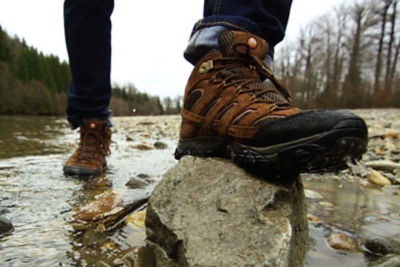How to Choose the Best Winter Jacket
Use these Pro Tips to find the best winter coat so you can bundle up with confidence this winter.

The leaves have fallen from the trees, the days are growing shorter and there’s a chill in the air.
Winter is here.
With freezing temperatures and snowy weather in the forecast, you’ll want to make sure you’re ready to brave the cold with a warm jacket. But what style is best for you?
DICK’S Pro Tips is here to help you find the one that can help you stay warm, even when the temperatures drop.
HOW ARE YOUR USING THE JACKET?
Before you look at all the specifications of a jacket, you should consider how you’re going to use it.
If you plan on doing a high-intensity aerobic activity like running or cross-country skiing, you may want to wear layers under a lightweight jacket.
But for lower-intensity cardio or those frigid walks from your car to work or school, a heavier jacket can help you fend off a chill.
INSULATION
When looking for a coat to help protect you from the cold, you’ll find two types of insulation from which to choose: synthetic and down.
Down insulation comes from the undercoating of ducks and geese known as plumage. The high-loft clusters retain your body heat while maintaining breathability. Down can also help wick away moisture to keep you comfortable. These jackets come with a fill rating that typically falls between 500 and 900. The higher the rating, the warmer the jacket.
The drawback of down? It loses its effectiveness if it becomes wet. If this is a concern, note that some down coats have insulation with water-resistant coating.
Down features:
- Ultralight
- Very warm
- Can be easily packed
- Long life span when properly cared for
Synthetic, meanwhile, is often comprised of polyester fibers. Unlike down, synthetic insulation can retain warmth when wet and dries easily. These materials mimic the warming qualities that you find in down. Synthetic insulation is measured in grams of a square meter. The higher the number, the more of that material used in the coat.
But there is a downside – synthetic insulation can be bulky and heavy. It can also be a little less durable than a down jacket.
Synthetic features:
- Water resistant
- Washing machine friendly
- Can be lower priced
OUTER SHELL
A variety of materials can make up the construction of a jacket’s outer shell. But your focus should be on how it stands up to the elements you’ll face.
Waterproofing properties, such as a weatherproof outer shell or a DWR coating treatment, can help your jacket retain heat and keep you dry. It can also be important to know the difference between water resistant and waterproof:
- Water Resistant: Can keep out light precipitation for short periods.
- Waterproof: Can keep out precipitation for longer periods of times thanks to sealed seems.
One of the most important aspects in how well your jacket protects against moisture is the type of seams used in its construction. This can be a major factor if you plan to wear the jacket for winter sports. The options include:
- Fully Seam Sealed: This means all the seams of the jacket seal tight to help protect against water.
- Critical Seams Sealed: This is when only the most exposed areas of the jacket have waterproof seams. This can include the shoulders, as well as the back and front of the jacket.
You’ll also want your shell to provide protection from bone-chilling winds. Wind flaps designed to cover the zipper can help shield you from blustering weather.
Also, don’t forget about sun protection in the winter. Some jackets come with a level of UPF protection to help guard you from the sun’s rays. This can be particularly helpful if you plan to be outside for longer periods of time.
LINING MATERIAL
This is the layer of the jacket that has the most contact with your skin and can help retain heat. The material used in the lining is a factor in your jacket’s warmth. Fleece or an extra layer of material are helpful for retaining heat.
A lining material that wicks away moisture can help keep you dry. But it can also keep you warm as it wicks moisture from your skin. This style of lining material can be particularly helpful if you plan on doing any physical activity while wearing your jacket.
OTHER FEATURES
- 3-in-1 design: These jackets combine a midlayer and outer shell that attach with zippers or tabs. You can wear the midlayer or outer shell on their own. The outer shell will often be water resistant. The midlayer can be made from a variety of insulation materials, including: down, synthetic, fleece or wool-lined.
- Hoods: Jackets with hoods offer a way to protect your noggin from precipitation, as well as keep it warm. Some hoods are adjustable for a snug fit, while others have insulation for extra warmth.
- Adjustment features: Jackets will come with a variety of features to help customize the fit. You can typically find hood adjustments, draw cords at the bottom of the coat to block wind and cold air and wrist cuffs to help seal out cold air. Front zippers can be in the form of a storm flap or be water resistant.
- Pocket features: Coats can offer a variety of storage options, depending on what you’re looking for. Some jackets will have flaps or water-resistant zippers to keep items safe. Security pockets can be on the inside near a seam or under a flap. Drop-in pockets can be handy for storing your hat or gloves.
- Packability: You’ll find jackets designed for easy travel. Some jackets can pack into their own pockets. Others will fold into a pouch or fanny pack.
By heading out in the best winter coat for your specific needs, you’ll be ready to experience all the joys of a winter wonderland.
Now that you know what to look for in a winter jacket, you’ll want to complete your battle armor against the cold. Check out these Pro Tips on choosing the right winter gloves.
Searching for the right size? Look for the True Fit icon on apparel and footwear product pages when shopping online at DICK’S Sporting Goods. Get personalized size and fit recommendations with just a few clicks. Learn more about True Fit.








